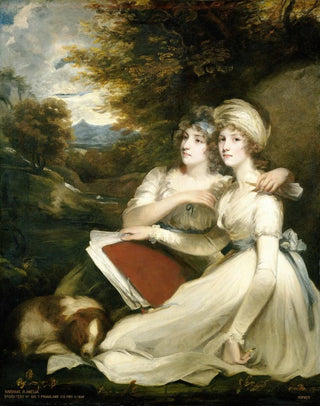Art print | The Frankland Sisters - John Hoppner


View from behind

Frame (optional)
In the captivating world of 18th-century British painting, the art print "Les sœurs Frankland" by John Hoppner stands out for its ability to capture the very essence of femininity and camaraderie. This canvas, depicting two young girls, is a true testament to the era, blending unparalleled delicacy with emotional depth. Observing this scene, the viewer is immediately transported to a realm where beauty and innocence meet, where every detail is carefully crafted to evoke an atmosphere of tenderness and intimacy. Hoppner, through his talent, invites us to contemplate not only the figures portrayed but also the human relationships woven around them.
Style and uniqueness of the artwork
John Hoppner's style is characterized by an intimate approach and a keen sense of portraiture, which is reflected in "Les sœurs Frankland". The way he plays with light and shadow brings the faces of the young girls to life, making their expressions almost tangible. The fluidity of the drapery and the finesse of details, such as delicately styled hair and elegantly adorned clothing, demonstrate a concern for realism that is characteristic of the artist. Every element of the composition, whether it be exchanged glances or subtle gestures, contributes to creating an atmosphere charged with emotion. Hoppner thus manages to transcend mere representation to offer a true moment of life, a fleeting capture of childhood and fraternal camaraderie.
The artist and his influence
John Hoppner, born in 1758, is one of the most renowned portraitists of his time, rivaling figures such as Sir Joshua Reynolds. His artistic journey is marked by constant evolution, shifting from a neoclassical style to a more romantic approach, allowing him to establish himself as a master of portraiture. Hoppner succeeded in capturing not only the appearance of his subjects but also their personality and essence. His influence extends beyond his era, inspiring many artists to explore the psychological depth of portraits. By highlighting the beauty and complexity of human relationships, Hoppner

Matte finish

View from behind

Frame (optional)
In the captivating world of 18th-century British painting, the art print "Les sœurs Frankland" by John Hoppner stands out for its ability to capture the very essence of femininity and camaraderie. This canvas, depicting two young girls, is a true testament to the era, blending unparalleled delicacy with emotional depth. Observing this scene, the viewer is immediately transported to a realm where beauty and innocence meet, where every detail is carefully crafted to evoke an atmosphere of tenderness and intimacy. Hoppner, through his talent, invites us to contemplate not only the figures portrayed but also the human relationships woven around them.
Style and uniqueness of the artwork
John Hoppner's style is characterized by an intimate approach and a keen sense of portraiture, which is reflected in "Les sœurs Frankland". The way he plays with light and shadow brings the faces of the young girls to life, making their expressions almost tangible. The fluidity of the drapery and the finesse of details, such as delicately styled hair and elegantly adorned clothing, demonstrate a concern for realism that is characteristic of the artist. Every element of the composition, whether it be exchanged glances or subtle gestures, contributes to creating an atmosphere charged with emotion. Hoppner thus manages to transcend mere representation to offer a true moment of life, a fleeting capture of childhood and fraternal camaraderie.
The artist and his influence
John Hoppner, born in 1758, is one of the most renowned portraitists of his time, rivaling figures such as Sir Joshua Reynolds. His artistic journey is marked by constant evolution, shifting from a neoclassical style to a more romantic approach, allowing him to establish himself as a master of portraiture. Hoppner succeeded in capturing not only the appearance of his subjects but also their personality and essence. His influence extends beyond his era, inspiring many artists to explore the psychological depth of portraits. By highlighting the beauty and complexity of human relationships, Hoppner






